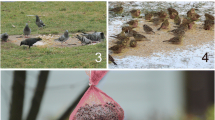Abstract
We carried out a survey of the feral rock doves (Columba livia) visible in the public areas of the fourteen Town Councils in Amsterdam. The objectives were to detect the preferential locations of the feral pigeons and to obtain reference values of their population sizes in order to be able to evaluate the effect of possible control measures. We registered 354 locations were twenty or more feral pigeons were visible during feeding. In these locations, averaged over ten to twelve counts, we counted 10,056 pigeons. Moreover we observed that at another 541 locations at least once five pigeons were visible during feeding. In all 894 locations we counted, averaged over four counts, 11,885 pigeons. By Town Council, we calculated strong positive correlations between the average number of pigeons per hectare, the human population density, the number of houses and the yearly number of kilos organic waste per hectare.
Similar content being viewed by others
References
Department of Environment of Amsterdam. (2001) Analysis of the Waste Disposal 2001 (in Dutch).
Haag, D. (1995) Regulation of street pigeons in Basel. Wildlife Society Bulletin 23(2), 256-260.
Hustings, M.F.H., et al. (1985) Bird survey, backgrounds, guidelines and reporting. Royal Dutch Institute for Nature Conservation (in Dutch).
Jokimäki, J. and Suhonen, J. (1998) Distribution and habitat selection of wintering birds in urban environments. Landscape and Urban Planning 39, 253-263.
Kautz, J.E. and Malecki, R.A. (1990) Effects of harvest on feral pigeon survival, nest success and population size. U.S. Department. International. Fish and Wildlife Technical Report 31, 1-16.
Lefebvre, L. (1985) Stability of flock composition in urban pigeons. Auk. 102, 886-888.
Murton, R.K., Thearle, R.J.P. and Thompson, J. (1972a) Ecological studies of the feral pigeon Columbal livia var. I. Population, breeding biology and methods of control. Journal for Applied Ecology 9, 835-874.
O + S (Onderzoek en Statistiek). (2000) Paragraph 2.1 territory, in Amsterdam in numbers. Publication of The Agency for Research and Statistics of Amsterdam (in Dutch).
Sol, D. and Senar, J.C. (1995) Urban pigeon populations: stability, home range, and the effect of removing individuals. Canadian Journal of Zoology 73, 1154-1160.
Sol, D., Santos, D.M. and Cuadrado, M. (2000) Age-related feeding site selection in urban pigeons (Columba livia): experimental evidence of the competition hypothesis. Canadian Journal of Zoology 78, 144-149.
Sol, D. (2001) Personal communication.
Author information
Authors and Affiliations
Rights and permissions
About this article
Cite this article
Buijs, J.A., Van Wijnen, J.H. Survey of feral rock doves (Columba livia) in Amsterdam, a bird-human association. Urban Ecosystems 5, 235–241 (2001). https://doi.org/10.1023/A:1025667127518
Issue Date:
DOI: https://doi.org/10.1023/A:1025667127518




